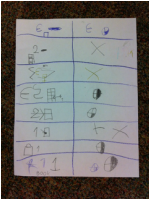Ka and Ba Today in class we discussed the ancient Egytian belief in two distinct parts of a person. The ka or "spirit" comes into existence when a person is born; crafted by the god Khnum on his potter's wheel. A persons ka was thought to live on after their body had died, alongside the mummy in the tomb. Offerings of food and drink were sometimes left at the entrance to the tomb so the ka could continue to eat and drink in the afterlife. The ba on the other hand, is essentially your "personality". It's what makes you - You! The ancient Egyptians believed that the ba, symbolized as a bird, would fly around and make itself useful during the day and at night would return to the tomb, looking for the mummy to which it belonged. I asked the students to take a few minutes and think about what makes them unique. What qualities define who you are? We discussed whether or not there is anyone else in the world exactly like them. I then asked them to write a word, a sentence, or a list to express who they are. Many students began by giving physical characteristics - hair color, age, gender. Then they moved on to listing what they like (cats, dogs, food) or like to do (play soccer, baseball, run, camp). We dug a little deeper when I asked them if they thought what they looked like or what they did is really who they are. Hmmm... a deep philosophical question even for adults! We took some of the examples of what they like to do (play the violin) and turned them in to qualities about ourselves (I am musical). Suddenly, many more qualities came to mind (sporty, playful, kind, curious, helpful, funny, awesome!). Wrapping up Mummy Students spent the remainder of the period working to complete their mummies, canopic jars, and sarcophagi. They painted gold masks on the plaster mummies they had prepared several weeks ago and continued to craft and paint their canopic jars. Those that had completed a mummy began to prepare a sarcophagus which we will decorate and fill next week to conclude our unit on mummies. Because we are making our sarcophagi out of shoe boxes, they will really look more like rectangular tombs or coffins. Next week we will add hieroglyphics, images of gods and goddesses, egyptian eyes, and any other decorations the students would like. Homework! Trinkets and treasures: Please have your student bring in any small treasures they would like to place in their sarcophagus, such as coins, buttons, small plastic or stuffed animal, toy food or utensils, etc. Word search: Last call for any student that wants to complete the word search and bring it to class for a small prize. Here is the file to download and print in case you did not pick one up in class. Enjoy the snow! See you all next week! Measuring Like Ancient Egyptians What do Pharoahs and pencils have in common? Neither one make a very good unit of measurement! The ancient Egyptian cubit was a measurement based on the distance from the Pharoah's elbow to his fingertips. Comments are closed.
|
Categories
All
Archives
May 2016
|





 RSS Feed
RSS Feed